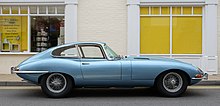Jaguar E-Type

The Jaguar E-Type, or the Jaguar XK-E for the North American mercat, is a British sports car that wis manufactured bi Jaguar Cars Ltd atween 1961 an 1975. Its combination o beauty, heich performance, an competitive pricing established the model as an icon o the motoring warld. The E-Type's 150 mph (241 km/h) top speed, sub-7-seicont 0 tae 60 mph (97 km/h) acceleration, monocoque construction, disc brakes, rack-an-pinion steering, an independent front an rear suspension distinguished the car an spurred industry-wide changes.[1] The E-Teep wis based on Jaguar's D-Teep racing car, which haed won the 24 Oors o Le Mans three consecutive years beginnin 1955, an employed what wis, for the early 1960s, a novel racing design principle, wi a front subframe carrying the ingine, front suspension an front bodywork bolted directly tae the body tub. No ladderfame chassis, as wis common at the time, wis needed an as sic the first cars weighed anly 1315 kg (2900 lb).
On its release in Mairch 1961[2] Enzo Ferrari cried it "the most beautiful car ever made".[3] In 2004, Sports Car International magazine placed the E-Teep at nummer ane on thair leet o Tap Sports Cars o the 1960s.[4] In Mairch 2008, the Jaguar E-Teep ranked first in The Daily Telegraph online leet o the warld's "100 most beautiful cars" o aw time. Ootside automotive circles, the E-teep received prominent placement in Diabolik comic series, Austin Powers films an the telly series Mad Men.[5]
References
[eedit | eedit soorce]- ↑ Jaguar Model Guides: The E-Type, www.jcna.com/library/news/2003/jcna0129.html.
- ↑ New Jaguar Car Has Top Speed Of 150 M.P.H. The Times, Wednesday, Mar 15, 1961; pg. 7; Issue 55030
- ↑ Classic Car Review 1964, articolo di Sean Curtis
- ↑ “Ten best Sports Cars of the '60s”, Sports Car International. May 2004. Issue 162. (Retrieved 2017-01-29.)
- ↑ John Storey (2010). "Culture and Power in Cultural Studies: The Politics of Signification". p. 60. Edinburgh University Press
